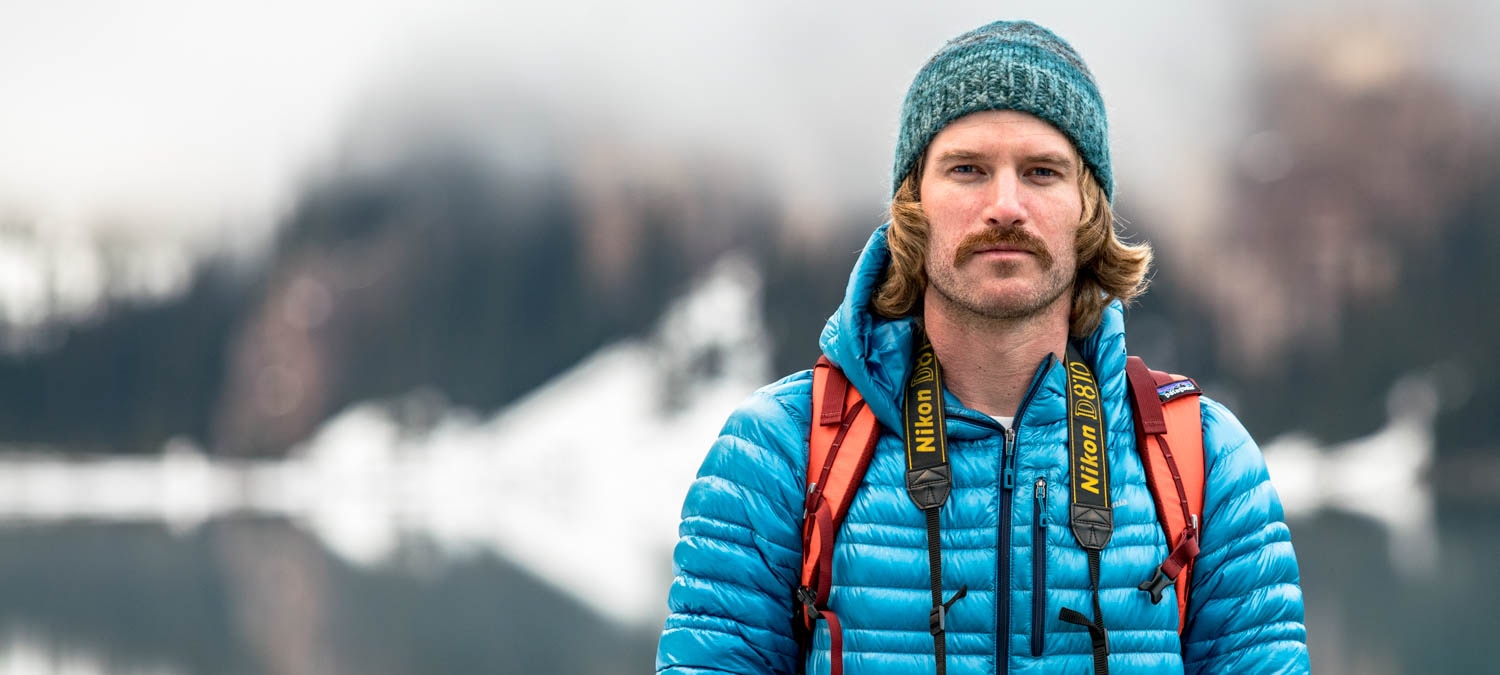There is a mixed climb in the Marconni Valley in Patagonia named La Piqueta Voladora, or “The Flying Axe,” so-named by first ascensionist Drew Smith, after an unwise 60-meter toss of an ice tool from leader to follower on pitch one. At least that’s what Drew told me as sat in my house in Missoula, Montana, four years ago. Scrawny from a few weeks on a dirtbag’s budget in South America, Drew replayed this story with energy and excitement, despite the dark circles under his eyes from lack of sleep. He had just returned from the alpinist’s playground of El Chalten, where he and his friend Jack Cramer put up the 230 meter 75º M4 climb. After the story and a few beers, Drew showed us hundreds of photos he had taken on the trip. They were raw—out of focus, the camera tilted in weird ways—but I felt like I was there. They told the whole story. Then, the shaggy-haired 28-year-old headed outside to sleep in his green SUV, which was crammed with a single bed on one side and duffel bags full of gear on the other.
Three days later, he was gone but his stories stayed with me. What I didn’t know then was that, years later, that couch surfer would be well on his way to becoming climbing’s next great photographer.
Although Drew, now 32, still lives in a vehicle, he upgraded a few years ago to a blue van. He’s climbed classic and stout aid and free routes in Yosemite, like Astroman (1,000′ 5.11c on Washington Column), Zenyatta Mondatta (16 pitch, 1,800′ a3+ aid route) and The Nose in a day (several times). He has been to Patagonia three times and spent two summers on the Yosemite Search and Rescue team. He’s gone all-in with his photography career, documenting his life as a climber. His timeless images could cover the walls of any climbing museum. The four climbers waiting in line in their sleeping bags to get a spot at Camp 4; a blond-haired girl in base layers in the passenger seat of his van, her feet up on the dash as she reaches for her coffee; an unthinkably cold and windy belay. When you look at a Drew Smith photo, you can see the sincerity—you see that Drew is not just documenting the world he sees, he’s living in it.
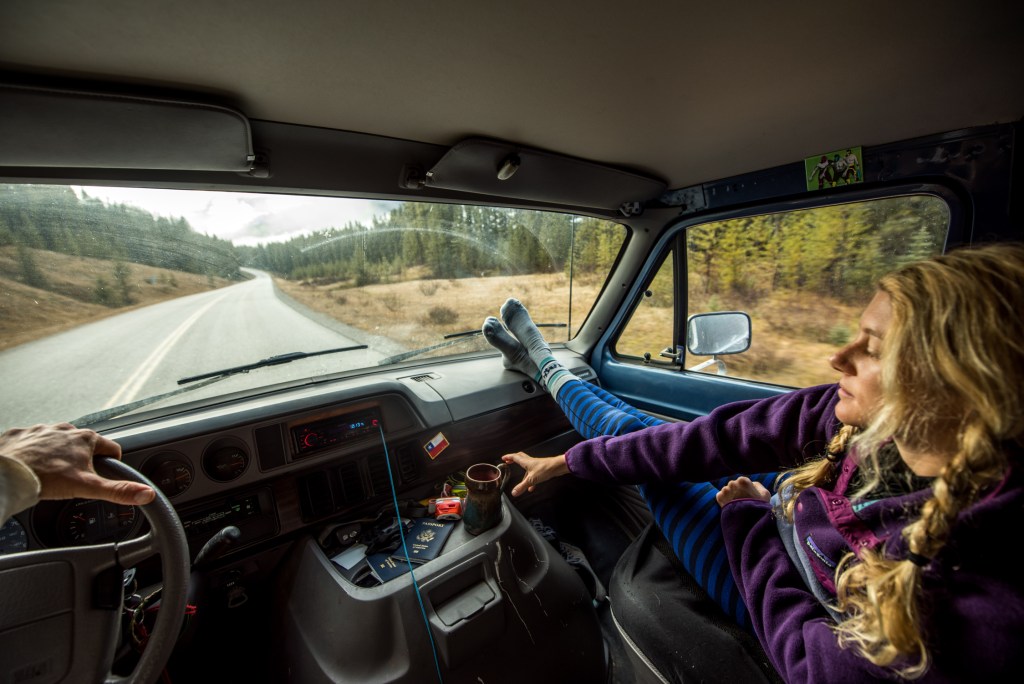
Photo Credit: Drew Smith
Drew was born in a small cabin with no running water or electricity outside of Drummond, Montana. His mom and dad were artists and ranchers, free-spirited and loving, and they raised Drew and his two older brothers, Garret and Mic, to do what makes them happy. His dad would always say, “Make goose bumps last as long as you can and enjoy cheap thrills.” In his opinion, goose bumps were good and they represented memorable experiences, and the Smith family didn’t have much money so any thrills had to come cheap. Drew spent his early childhood on a cattle and sheep ranch until his family moved to Miles City, Montana, where he and his brothers would blast around on motorcycles, sled down dirt hills and snowboard behind sled dogs in the winter. The brothers collectively broke 10 bones by the time Drew was 19.
After graduating from high school, Drew decided to do a two-year welding program at the University of Montana in Missoula. “I remember thinking I was going to do this program, find a wife, buy a house and get married,” he says. But two weeks in he was already unhappy and dropped out; college just didn’t feel right. He got a job working at a fish hatchery on an island in southeast Alaska and spent six months with two 40-year-old hunters who thought he was crazy because he would go explore the undeveloped and grizzly bear-ridden wilderness alone.
After Alaska, Drew bought an old station wagon for $500 and drove 2,370 miles down to Baja with his best friend, Ber. They ate white bread with peanut butter and for dinners they’d do spaghetti noodles with the cheapest sauce at the store. “I was 20 and he was 19. We took five months to get there and when we did, we lived on the beach and learned how to surf.” One evening as the trip was coming to an end, Drew asked Ber what he wanted to do for a living. “Well, I like traveling so I think I’ll just do that for the rest of my life,” Ber told him.
“I thought that was pretty cool,” Drew says. “I decided I could do that too.”
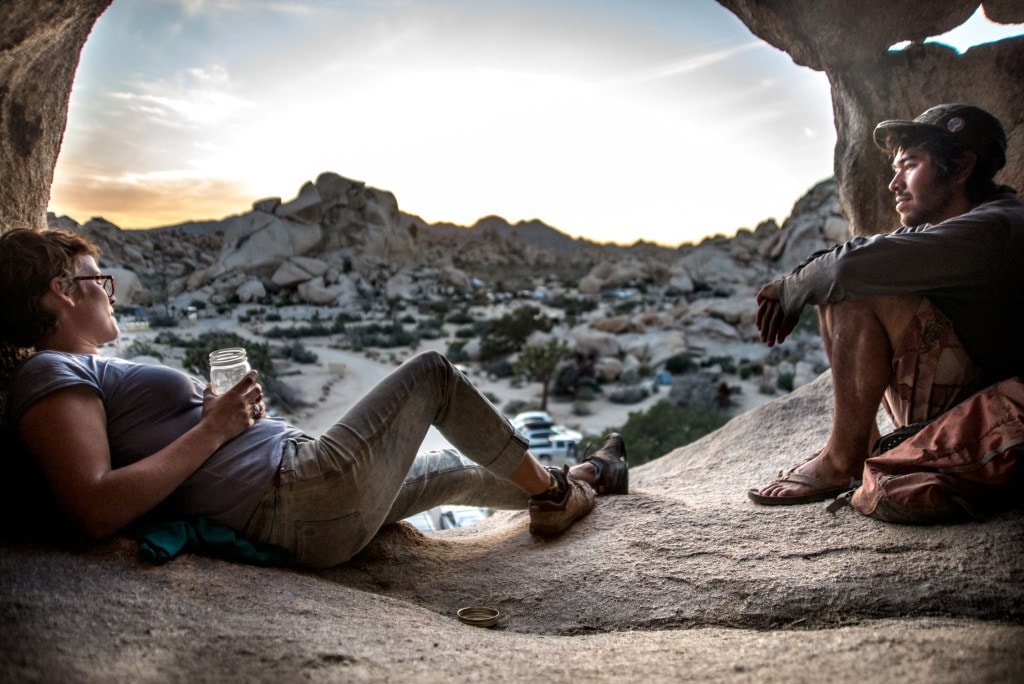
Keo Boulton and Caileen Brandt at Joshua Tree, Calif. | Photo Credit: Drew Smith
Drew kept going back to work in Alaska for the following two summers. During the rest of the year, he’d wander alone around the world, to Southeast Asia, Europe and South America looking for the types of adventure you can’t find in guidebooks. Once he befriended another traveler in Laos and they rode buses for two days, bought a handmade wooden canoe for $70 and went down a random river for five days. He got a tattoo on his foot that says “drift” in Thai. “I remember being 21 when I got it and I felt like a bottle in the ocean that was just floating around. I had no clue what my passion was or what I wanted to do. I just knew I wanted to be happy.”
That’s that mentality that brought him to Jackson Hole, Wyoming. He missed snowboarding. (When Drew was a kid he’d always gone skiing at Red Lodge Mountain with Ber’s family.) He got a job as a groomer at the ski resort and snowboarded daily until he went too big off a jump and landed so hard he compressed five vertebrae, bruised a lung and bit out chunks of his tongue.
Before his accident, Drew was already planning on leaving Jackson; after so much time traveling, being in the same spot for more than a few months made him antsy. But because he needed to heal, he stayed and got a job at the local mountain shop, Teton Mountaineering. That’s how he found climbing. “Hanging at that shop, I was with climbers and got completely addicted,” Drew says. When his back healed he started climbing a lot. He took to the Tetons and started ticking off the classics despite struggling to find climbing partners willing to go out with a newbie. Then, he made the snap decision to buy a one-way ticket to South America, with no plan at all. He stayed for more than a year, traveling, picking up odd jobs and climbing.
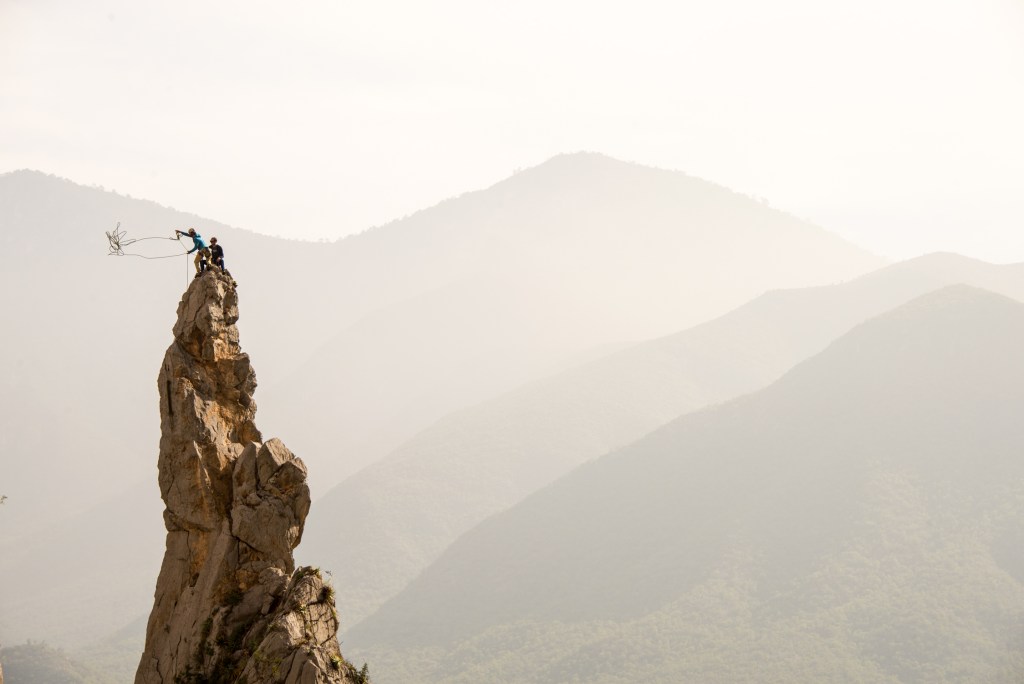
Mike Holland and Peter Hudnut prepare to descend after climbing Las Agujas, El Potrero Chico, Mexico | Photo Credit: Drew Smith
In 2010, Drew came home, moved into his pickup truck and started an endless climbing road trip. This was also when he got his first camera. “My brother Garret gave me my first DSLR camera, and I gave him a climbing rope in return,” Drew says. “He also set up a blog for me and anytime Garret and I would talk he would tell me to update my blog.” From then on out Drew took his camera everywhere, knowing Garret would bug him if he didn’t.
“When I was trying to think of a good name for the blog I thought back to this conversation that me and this girl I [was] pretty in love with in Jackson had once. I left her when I went to South America and she was like, ‘Drew, I just wish you just had a plan.’ That’s why I named the blog Drewsplan. Because that was my plan from then on out: to take photos every day.”
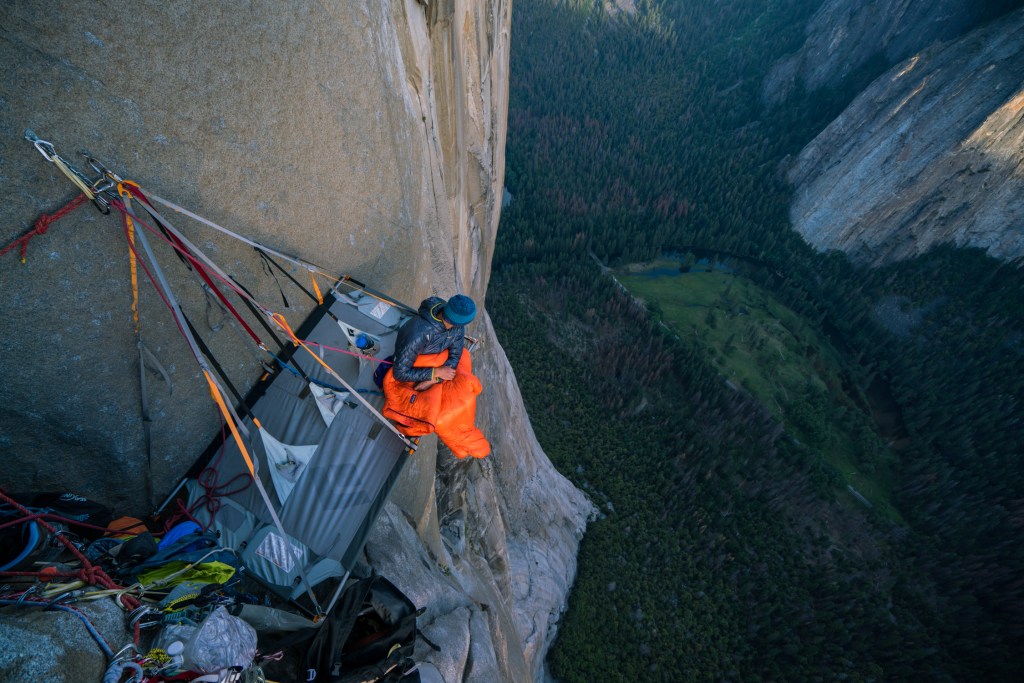
Bronson Hovnanian at Sous Le Toit, Pitch 22, up El Capitan while attempting to free climb Freerider 12d, 30 pitches. Yosemite, Calif. (Photo Credit: Drew Smith)
His climbing chops grew, and Drew joined the esteemed Yosemite Search and Rescue (YOSAR) team in the summer of 2015. “I was climbing in Yosemite and a buddy was like, you should apply to YOSAR. I ended up getting an interview and a couple days later they called me to say I was on the team. I was like ‘Holy shit what a dream!’” Drew says.
Around the same time, Drew sold his first photo. It was a picture of a woman (his girlfriend at the time) in the back of a truck with the giant sport climbing walls of El Potrero Chico in the background. At that point Drew had been shooting photos of climbers for five years and he was beginning to develop a style and process. “People have always told me that I shoot too much,” Drew says. “But with doing that I’m able to capture that one moment.” Capturing real, authentic moments has always been the most important part of shooting climbing for Drew. He doesn’t pose people, and he cares more about being friends with his subjects than getting a paycheck.
“Drew is one of the most dedicated photographers I know,” says Savannah Cummins, who is also an adventure photographer and climber, and the subject of the Potrero shot. “He catches moments that most photographers let slip by. We can be looking at the same thing and I won’t break out my camera because the light isn’t good or it’s just not compositionally worth it, but Drew always takes the photo.”
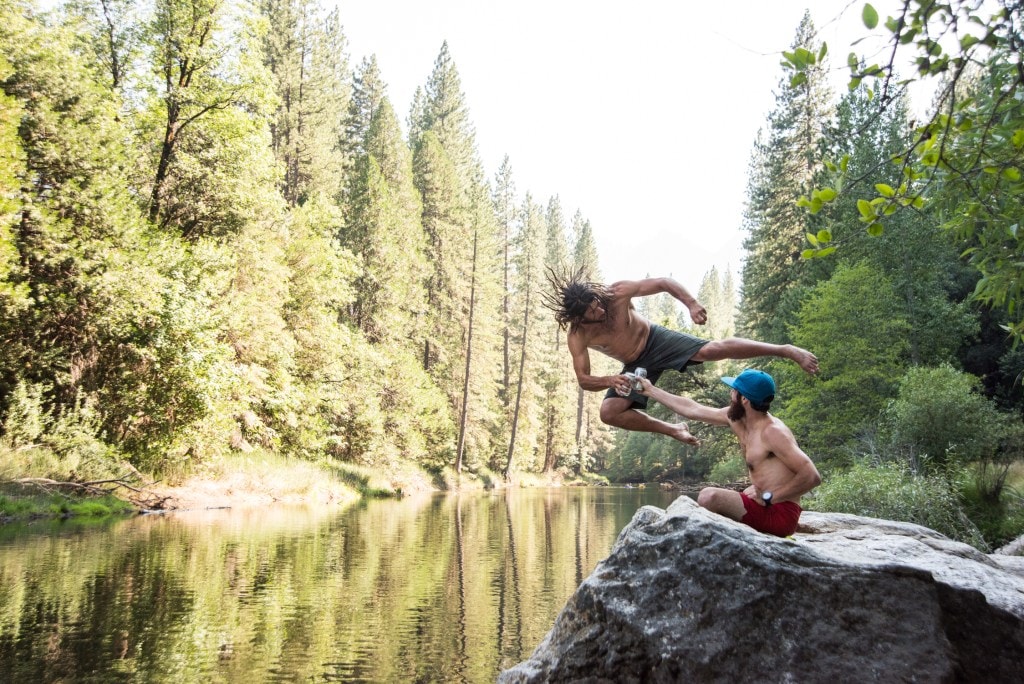
Ken Kries and Josh Huckaby cheers to summer while jumping into the river. Yosemite Valley, Calif. (Photo Credit: Drew Smith)
Drew worked for YOSAR and lived in Yosemite for two summers, and in his free time he’d go out with local climbers. He shot Brad Gobright on the Salathé Wall on El Cap, Robbie Phillips on Pre Muir on El Cap and Nina Williams on The Final Frontier. After summer, he went with Mayan Smith-Gobat and Brette Harrington to shoot video of them on Riders on the Storm on the Central Tower of Torres del Paine in Chile. “As an experienced climber and alpinist himself, Drew does not interfere with the climb, but enhances it by producing the photographic memoir,” says Harrington. “He is highly experienced on ropes, having worked in YOSAR and being a big wall climber himself, so it’s really easy to work with him.”
Drew says hanging with his heroes all the time is inspiring. “The other day I was talking with Mikey Shafer, and it’s so cool being around these people who are my heroes and now they are my friends. But I don’t think I’m killing it right now. I don’t ever want to think I’m the shit.”
But in reality, Drew is really, really good. So good that he has landed one of the most coveted positions a climbing shooter can have: being a contributing photographer for Patagonia.
“The main reason I was excited to work with him was because he was truly living the lifestyle that we like to portray in our imagery,” says Kyle Sparks, photo editor at Patagonia. “I didn’t have to give him any direction because he was out there doing it every day. He is one of our up and coming contributors, and we are super psyched to work with him.”
This past fall, you might have seen a Drew Smith shot on the cover the Patagonia catalog. It’s a photo of his friend Matt Steele lounging on a portaledge on a route called Prodigal Sun in Zion—with a backdrop of red, yellow and orange foliage below. “One of Drew’s biggest talents is his ability to make us feel small,” says his brother Garret. “He does such an amazing job of showing the environment the person is in.”
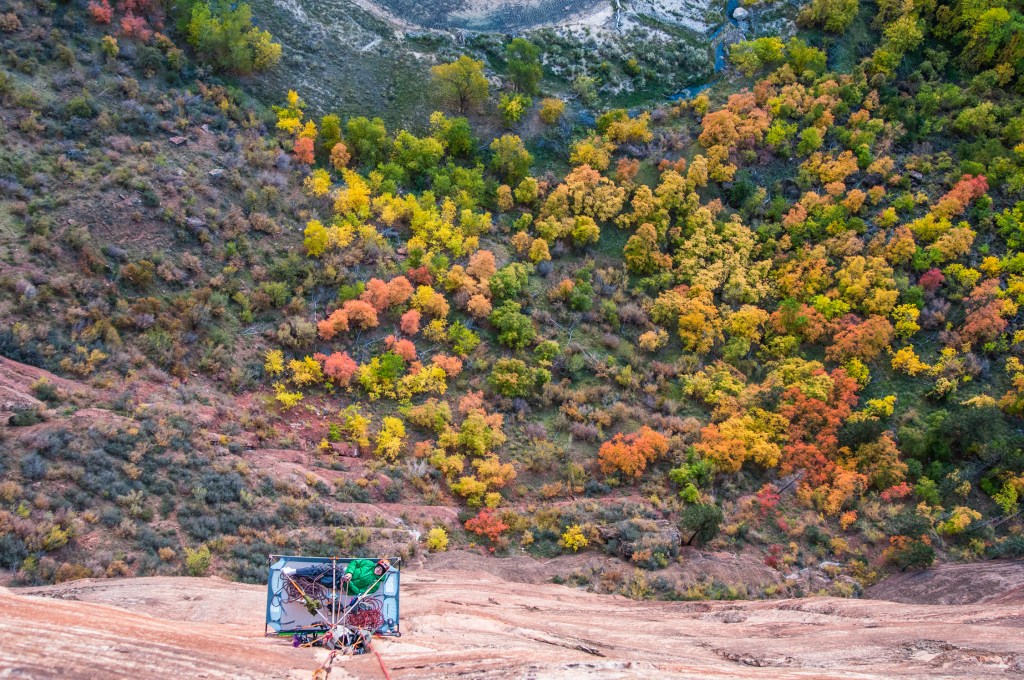
Matt Steele belaying on the portaledge, Prodigal Sun, Zion National Park, Utah. (Photo Credit: Drew Smith)
“I work a ton at my photography and don’t make that much money but I’m super happy and I can see a future in it,” Drew says. He still has this goal of one day being stable, in one place with a house and a partner and some good income, but he doesn’t really know when that will happen and he’s not that concerned about it.
Most recently, Drew got back from his best trip yet. He went back to Cochamó with Robbie Phillips and Ian Cooper. The British climbers were trying the La Junta project on La Junta wall in Cochamó Valley. The route has two 5.14 pitches and will be 20-something pitches when it’s complete. “We were all just so happy and just laughing all the time,” Drew says. “I felt like part of the team. And I got a lot of photos.” A few weeks ago he sent 2,000 of them to Patagonia. I’m sure there are more catalogue covers coming his way.
Every time I’m traveling around climbing with my own camera in tow, I think about Drew. I picture him driving around the country in his beater van, dealing with life’s ups and downs one day at a time. I wonder if he is doing OK. Is he getting too bogged down by the solo travel, seasonal work or the seemingly impossible task of making a living solely by taking climbing photos? Maybe. But then I think about how he’s probably stuck in a blizzard somewhere, or up on a big wall in Yosemite, or shooting gritty off-width climbers in Indian Creek, and I know that all of it makes him happy. Us too.
